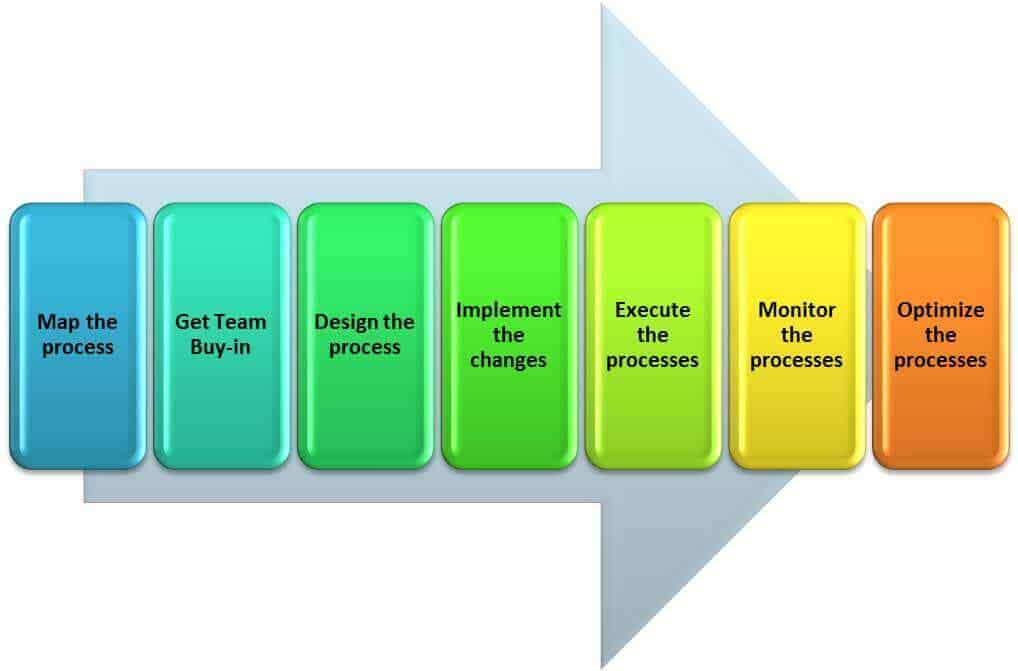What Is Business Process Improvement?
Business process improvement (BPI), also known as functional process improvement, is part of organizational development. The goal of a BPI project is to systematically improve or put processes in place, and the desired result is to offer enhanced products or services to the consumer and to increase operational efficiency. BPI is a wide-ranging term that can cover many actions, from incremental continuous improvement (CI) to the radical transformation of a business, known as business process reengineering (BPR).
Business processes are a series of linked tasks, with defined starting points, that lead to the delivery of a service or a product. Any time an organization wants to remove waste and redundancy or put new strategic goals in place, it can undertake a BPI project. Often, businesses kick off BPI projects when they discover there are no defined methodologies in place.
A BPI project may use several different methodologies or combinations of methodologies, techniques, and tools. Some popular methodologies include Six Sigma, Lean management, Lean Six Sigma, Agile management, reengineering, Total Quality Management, Just-In-Time, Kaizen, Hoshin Planning, Poka Yoke, Design of Experiments, and Process Excellence. Many of these methodologies promote similar process improvement cycles with a varying number of steps or phases.
A process improvement cycle is the series of high-level steps that a BPI project goes through. Most include one or more steps that identify the need for change, analyze current processes, get organizational support, create new processes, and follow up on those processes. Then the cycle starts over again. It is described as such because a cycle continues the process improvement and does not stagnate at one result.
BPI projects can also have the goal of creating more efficient workflows. Workflows are a series of steps or events that produce a desired result. They delineate the steps, the resources (such as staff or equipment), and their interactions. Workflows are diagrammed in process maps, which are graphical representations of workflows and business processes.
An important part of any BPI project is change management, which is a systematic approach to enabling adjustment and development within an organization at the individual and business levels. Change management is meant to be proactive, with experts connecting the business value proposition to the personal perspective. In the case of BPI, experts recommend having a change management team in place prior to the project to manage staff expectations around the adaptations and to check in frequently.
Technology is a crucial part of any BPI initiative, but it is only one aspect of the overall plan. This is especially true when the processes targeted for improvement include newly installed or upgraded technology. For example, smart factories may be the pinnacle of technology undergoing constant improvements, but experts recommend that the organization’s strategic goals, rather than technology, should drive BPI. Process changes should come before implementation of new technology to decrease any negative impact. Additionally, changes to process and technology should not be performed simultaneously.
Business Process Improvement vs. Business Process Management: What’s the Difference?
The goal of BPI is continuous improvement, whereas business process management (BPM) is the administration of the processes in a company, regardless of how well they are set up and run. There is no requirement in BPM for continuous improvement, but there is a requirement to strategically align the company’s processes.
Business process management software (BPMS) supports the principles of BPM and BPI. Since BPM is a holistic discipline, you benefit from having software that is aligned with the mission. One note on software for both BPI and BPM: Make sure that whatever software package you choose is not too complicated for your staff and has the features that support the projects you plan to undertake.
The Purpose of Business Process Improvement
The purpose of BPI is to continually improve process productivity and to generate the right results consistently. A successful process is one that regularly delivers the expected product or output. The process should use the most efficient resources to produce an outcome at the expected minimum cost. The product should always work as expected and get there in the appointed time.
Your customers set the standards, and their expectations become your process indicators. It is the process manager’s responsibility to constantly review these indicators and ensure that they are keeping up with the marketplace. The manager must also ensure that the process does not favor one indicator at the expense of the others. BPI should improve the effectiveness, efficiency, and quality of your processes.
One example of a good BPI initiative that businesses undertake is the order-to-cash process, in which reducing the process cycle (completion time) delivers a clear benefit to the company’s bottom line. In companies that do not operate in a brick-and-mortar environment, this cycle time is especially critical to survival.
In this process, the order is taken, the order and inventory are reconciled, the goods or services are assembled, the quality of the assembly is verified, the goods or services are dispatched and delivered, the client is invoiced, payment is made, and reporting is performed. This process is lengthy, and it’s ripe for errors and bottlenecks. The more personnel are involved, the longer the cycle time. BPI could make a huge difference.
Other benefits of BPI initiatives include:
- Increased profits
- Documentation of savings and control plan
- Promotion of safety
- Reduction of process friction
- Greater automation
- Identification of process system deficiency root causes
- Elimination of bottlenecks
- Decrease in pollution
The Significance and Objectives of Business Process Improvement
No business wants to remain static. To compete and win, your organization has to not only keep up with the challengers, but also find an edge over them. BPI projects enable your business to do the following:
- Enhance customer experience
- Increase productivity and efficiency
- Increase capacity from the existing footprint
- Improve the customer service and teamwork
- Reduce rework and overprocessing
- Improve internal and external communications
- Standardize end-to-end business processes
BPI projects are significant because they push organizations toward becoming procedure-focused enterprises. Using a multidimensional viewpoint, BPI projects often review the basic aspects of high-performance procedures and push companies to ask questions about them. After ranking and prioritizing the known issues, companies should ask these questions:
- What are the most important issues that BPI project should address?
- What level of improvement is expected? Is it realistic?
Every BPI initiative should meet specific objectives for the organization. In assessing the project, managers should review the following criteria, and determine whether the project has achieved them and how they could better fulfill them in the future.
- Effectiveness: This is focused mostly on the delivery needs of your end users, especially your customers and clients. Project managers should ask whether the intended results have been achieved and whether the process is able to deliver what is needed.
- Efficiency: This focuses on the people who are responsible for the overall process, who is performing the process, and if the process is user-friendly enough. For this criterion, project managers should determine whether any bureaucracy has been eliminated and whether minimal resources are needed to achieve results.
- Adaptability: This assesses whether the new process can be modified as the business requirements change. Project managers should determine the process’s flexibility by measuring along the way.
BPI initiatives are not just relevant to technology and big business. There are many use cases. For example, you can apply BPI projects to marketing campaigns, HR onboarding or hiring practices, sales orders, IT ticketing or service desk, the procurement process, consulting services, materials requests, and compliance requirements. In marketing, you can conduct a BPI project to automate your communication, thus decreasing the time it takes to launch new campaigns. You can also implement an approval process that checks for and eliminates errors in your copy. In IT, you can develop a process to automate the assignment of service requests to your team and introduce a process that pulls in a new hire’s details to their software account for setup.
The Role of Business Process Improvement Consultants
Consulting firms that specialize in BPI can offer organizations a degree of objectivity when assessing their processes. Using their deep industry knowledge and BPI experience, consultants can identify and prioritize which processes should be improved, as well as design and implement appropriate solutions. In their assessment, consultants look at the maturity of your processes, how they are performing, the level at which they are expected to perform, and how to reconcile the reality with the requirements.
Process maturity refers to the degree of formality and level of optimization of a process, whether they are makeshift practices or formally defined steps that include milestones. The continuum of process maturity goes from ad hoc to fully optimized practices. A more mature process emphasizes a framework with service-level agreements where everyone in the organization is working under a coordinated effort to put a plan into action. Further, in a mature process, the metrics are defined. Process maturity also indicates completeness: its usefulness, automation, and reliability.
A business can assess process maturity by looking at the following criteria:
- Leadership: This includes accountability, management, and oversight of the process. Ideally, there is a leader for the whole process.
- Teamwork: This is whether the teams that work on the process are cohesively structured.
- End-user link: This is how closely the end user, whether an external client or internal staff, is engaged in the process design.
- Metrics: This is how well the metrics of the process are defined.
- Automation: This is the extent to which the process is automated.
- Clarity: This is the extent to which the process is laid out and understood.
- Continuous improvement: This is the series of regular appraisals and improvement events.
- Universal: This is how well the process is used across the business.
The ultimate goal of determining process maturity is to reach process excellence. Process excellence is about more than just improving processes; it is about changing the way your people work and act. Only then are your personnel able to solve problems and manage change and performance in order to align with your business objectives. To achieve true process excellence, companies must first understand several details, including what type of improvement program they are using, what are their goals, and what is the best way to integrate technology into their project.
This is where BPI consultants come in. They can administer the projects on behalf of the company, help the company decide on the methodology to use, and support the company through their project. Here are some examples of types of support that consulting firms can provide:
- Construction development management
- Loan of project monitoring
- Feasibility studies
- Cash flow projections
- Management and HR consulting
- Team and individual development
- Organization transition
- Supplier development
- Academic institution process improvement
- Meld processes for new partnerships
Business Process Improvement Methodologies
Improvement methodologies are often used to tweak processes, because their structure keeps the business from failing or floundering during the adjustment phase. However, according to Mark Gershon, the majority of business process improvement projects still fail. The reasons for this, according to Scott Lowe writing for TechRepublic, are:
- Lack of support from the top
- The organizational culture
- Noncooperative team members
- The project team is not responsive
- The initiative is too focused
Process improvement methodologies have also historically differed in their effectiveness. Adesola and Baines say that no one methodology can address all of the necessary phases of a BPI project, and some practitioners recommend combining methodologies for the best outcomes.
BPI initiatives use well-known methodologies, including Six Sigma, Lean, Kaizen, ISO 9000, Theory of Constraints, Global 8-D, and Rummler Bache. These methodologies share the philosophy that processes can always improve. They also work under the assumption that measurements and statistics are the key to improvement. Finally, they hold the idea that the workers closest to a process are the best people to improve it.
For more information, read these brief overviews of some of the methodologies below:
Six Sigma: Six Sigma is a quality measure that seeks to remove defects, errors, and redundancies through concentration on outputs. Five phases comprise Six Sigma: define, measure, analyze, improve, and control (DMAIC). This approach helps figure out the defects in the processes and how they are caused and classified. Then practitioners review ways to improve them.
Other tools in Six Sigma include Design for Six Sigma (DFSS or DMADV), cause-and-effect analysis, and SIPOC analysis. DFSS is the method used to improve processes, bringing them to the Six Sigma quality level. A cause-and-effect analysis, also called a fishbone or Ishikawa display, is the visual diagram of a process that shows causation of issues or effects. In a SIPOC (supplier, input, process, output, and customer) analysis, each category is a header in an analysis that enables you to scope out projects. Six Sigma is often combined with Lean manufacturing. This mix is known as Lean Six Sigma and capitalizes on the strengths of both methodologies. When used together, they can be applied in all phases of an improvement process.
Lean: Lean is a quality measure that seeks to reduce waste and improve workflow. Lean thinking says that any activities that do not produce value are a waste and should be cut out of the process. Lean has five phases: sort, straighten, scrub, systematize, and sustain (5S). It also uses the value stream mapping tool to create a diagram of the workflow of materials and information that get your products or services to your customers. These can be current state maps or future state maps.
Kaizen: Kaizen focuses on small continuous improvements in large numbers, and it involves all employees. Kaizen emphasizes more value and less waste in a gradual, incremental, constant manner. Kaizen includes four steps: plan, do, check, and act (PDCA). Kaizen is a rapid improvement technique, because the problems are clearly defined and the solutions are already known. Kaizen projects are minimal risk. Some experts recommend combining Kaizen with Six Sigma so that improvement happens on an ongoing basis with an occasional breakthrough.
ISO 9000: Although ISO 9000 is a system of administration and not an improvement system, it is considered the international standard for quality. The European Union formally accepts ISO 9000, as does the remainder of the world. ISO 9000 requires that processes are documented for the company to be “certified.” Once certified as ISO 9000, a company is not required to continually improve its processes. However, ISO has recently added continual improvement standards to its family of quality management.
Theory of Constraints (TOC): This quality improvement methodology caters to the restraints and bottlenecks in processes. Using process flow analysis, TOC deals with one bottleneck, which exposes another bottleneck that needs attention. This may be considered a type of TQM or continuous improvement because of the continuous cycle of fixing and exposing bottlenecks.
All these methodologies may be part of a business improvement strategy. The key to success is knowing how and when to apply each to the various process improvement opportunities. Experts recommend educating yourself and your team in all three methodologies to accommodate the needs of different projects.
Business Process Improvement Steps
BPI plans can draw from many methodologies and approaches. DRIVE is one such approach, especially when you are first drafting your processes. DRIVE stands for:
- Define the process scope, what success looks like, and what deliverables are reasonable.
- Review your current process; identify and collect any relevant data.
- Identify process improvements and ways to sustain them.
- Verify, prioritize, and plan the improvements that will achieve the defined goals.
- Execute the plan, get feedback, and review.
Other approaches include Statistical Process Control, Simulation, and RAPID. RAPID is a type of BPI improvement methodology developed by the Business Process Improvement Shared Service, a compilation of peer-reviewed methods from several leading universities that are part of the Network for Change and Continuous Innovation (NCCI). RAPID stands for:
- Review the problem
- Assess the current state
- Plan for change
- Implement changes
- Determine success
RAPID is ideally suited for Kaizen events because they are performed quickly, incrementally, and in real time.
To take your company to the next level where your processes are optimized, regardless of defined approach and methodology, you should consider the following seven steps.
- Map the process. Since processes flow into each other as rivers do, a map is appropriate. Identify choke points and the customers’ experience, and gather the resources involved. Understanding the project and having clear objectives in mind is critical to a successful project.
- Get team buy-in. This step gets your organization on board with the necessary process improvements. Without this, all of your improvement efforts will fail.
- Design the process. This step takes into account the outcomes that would add value in achieving the business objectives and the best way to align the processes to achieve these outcomes. This is the desired process. Reorganize the workforce in the organization based on the desired outcomes by means of the tools available in the BPI process.
- Implement the changes. Changes to the processes should be implemented using known tools.
- Execute the process. Is automation appropriate? Even the best-laid plans may have to change due to real experience.
- Monitor the process. Continue to review your processes for ways to make them more efficient and better optimized. Measure, measure, measure. In this step you are verifying that the defined goals are being achieved.
- Optimize the process. Experience is the best teacher. Using your lessons learned, continue to improve to maintain process excellence.
Expert Strategies for Business Process Improvement
We can learn numerous lessons from the professionals who use BPI every day. Many of their points are hard won and based in experience and struggle. Some experts even recommend deploying an enterprise risk management (ERM) professional concurrently with your BPI projects. Each of the following professionals use BPI in a variety of fields, and they give their perspective and tips on how they approach BPI.
- Define what “good” looks like before you start: Why are you looking to improve your business process? If the project is successful, what will be different? How can that be measured?
- Document the current business process: Who are the actors involved? What are their goals/objectives? What are the steps? Where is there friction?
- Identify stakeholders and value map: Who are the stakeholders in the process, both internal and external? What value is being added, exchanged, and removed from the process? Where are the opportunities to add/extract new value?
- Impact analysis: Which stakeholders would be affected by a successful project? How will they be affected positively/negatively? How would a new process align with corporate/division-level goals and objectives? How much change is required? How ready is the organization/team for change?
- What is obvious and opaque: What are the obvious solutions? Why aren't they already implemented? What are the unseen/unspoken barriers to change?
“After you've done the initial work, then you are ready to start developing and testing hypotheses on new processes and how they would achieve results that align with ‘what good looks like.’"
Norcross continues, “According to a BP Trends report, 20 percent of businesses take on BPI initiatives, while 66 percent of businesses never or only occasionally perform process improvement projects. We also know that 33 percent of BPI projects fail.”
In his words, here are the three biggest reasons why:
- Lack of executive-level support: Some projects are initiated by teams looking to improve the business, but without the air cover of executive level support for change — and often without the budget necessary to run a complete project. The first step has to be aligning the BPI project with corporate objectives and getting a C-suite sponsor.
- Lack of organizational readiness: Many BPI projects have far-reaching impact beyond the team leading the project. If the organization isn't ready, there will be multiple levels of resistance. Figure out in advance who will be impacted and make sure that they see the value/benefit in making the change. Check to see that the setup is not too lengthy to avoid burnout before the project begins.
- Aversion to risk/fear of failure: Improvement requires change. Change is risky, and sometimes projects or phases fail. Failure is part of learning and growth, yet many fear failure. Everyone must be able to understand, evaluate, and mitigate the risk associated with change. A simple way to approach this is to look at individual goal and performance review metrics and ensure that they allow for (or even encourage) the change necessary for a successful BPI project.
“The bottom line: Changing a business process from paper-based to online or from manual to automated in order to reduce cost and increase efficiency is the easy part. The real work is understanding the organization, the people, the objectives, and the tolerance for risk before you start.”
“The result of using ’freedom within a framework’ to develop and improve processes is that when it's executed properly you get happier team members more effectively solving challenges and completing work. This whole concept closely relates to micromanaging. Nobody likes it, and ‘freedom within a framework’ can be a great brief reminder of how to avoid bringing it into your process development and BPIs.”
Take note of other lessons learned by experts from around the web with respect to BPI projects:
1. BPI can teach us more about our staff. The staff may not be lazy, but they may have bad or inefficient processes. They are the experts on their work and should be the ones who help make changes. Also, it is unrealistic to expect them to be experts at every stage of a process.
2. Don’t forget to standardize the process handoffs. Determine the sequence of steps for handoffs and who is responsible for what. You can determine how formal it needs to be, based on your organization’s procedures.
3. Your last meeting on any BPI project should be a “lessons learned” meeting. You will thank yourself in future initiatives.
4. Celebrate the wins! This helps to keep your team morale high.
Business Process Improvement Training
Many companies offer training for BPI. The vast majority of these courses are limited to a few hours or one-day workshops. The prerequisites usually include a firm understanding or experience with business modeling and mapping. Only a few list specific methodological experience or understanding as a requirement, although experts recommend having a grasp of each. Each methodology has its own perspective on BPI, and courses may be found that are consistent with each, as well as some mixed-methodology courses. Methodology-neutral courses are available, but they usually boast that their own model is the “best” to follow for improvement initiatives.
Finally, all of the courses give practical or hands-on tips and tricks. In general, the professionals who take these courses already have experience in business process management and are best served by additional coursework as they can directly apply the concepts.
Improve Business Processes with Powerful, Automated Workflows in Smartsheet
Empower your people to go above and beyond with a flexible platform designed to match the needs of your team — and adapt as those needs change.
The Smartsheet platform makes it easy to plan, capture, manage, and report on work from anywhere, helping your team be more effective and get more done. Report on key metrics and get real-time visibility into work as it happens with roll-up reports, dashboards, and automated workflows built to keep your team connected and informed.
When teams have clarity into the work getting done, there’s no telling how much more they can accomplish in the same amount of time. Try Smartsheet for free, today.





